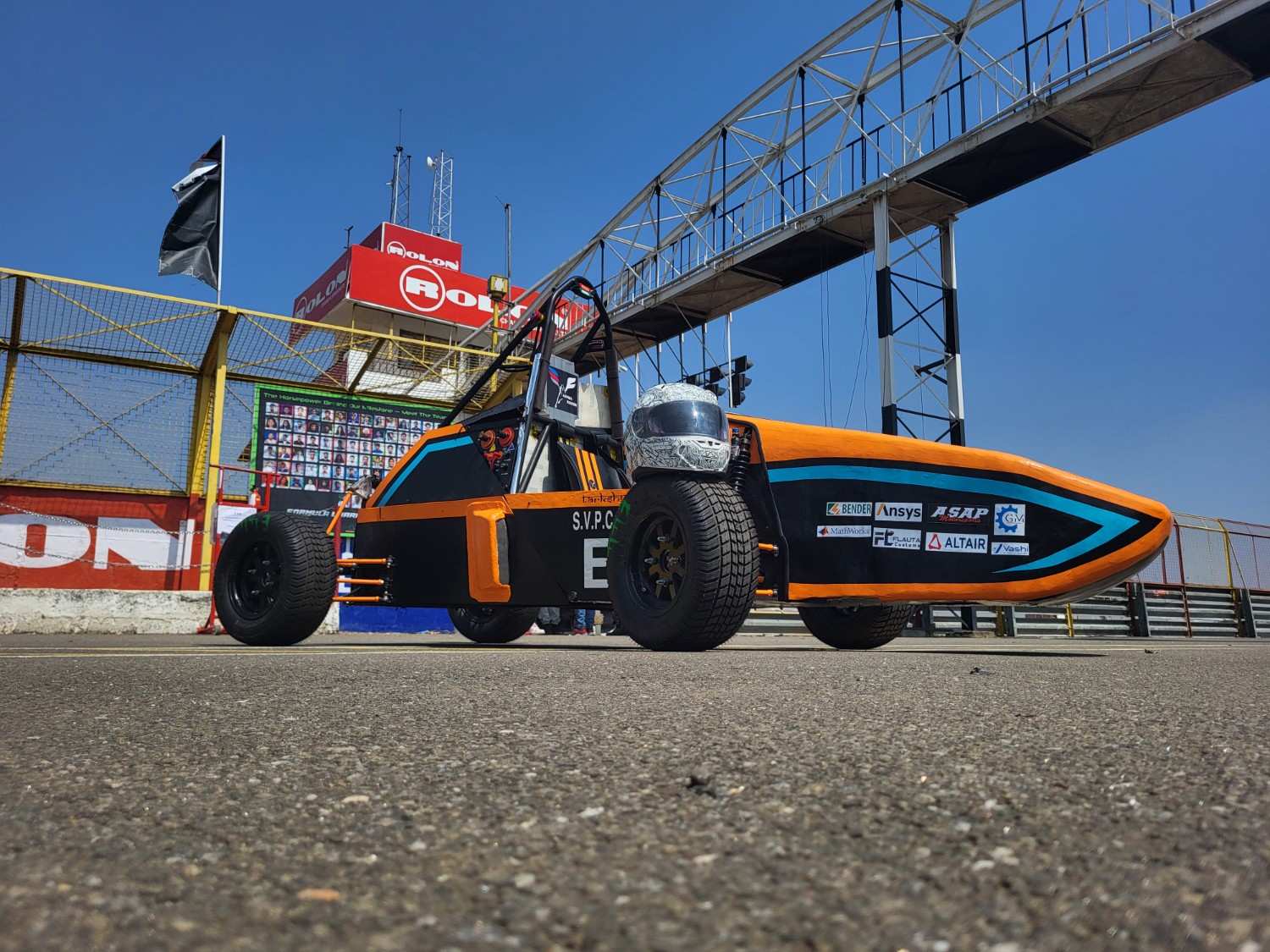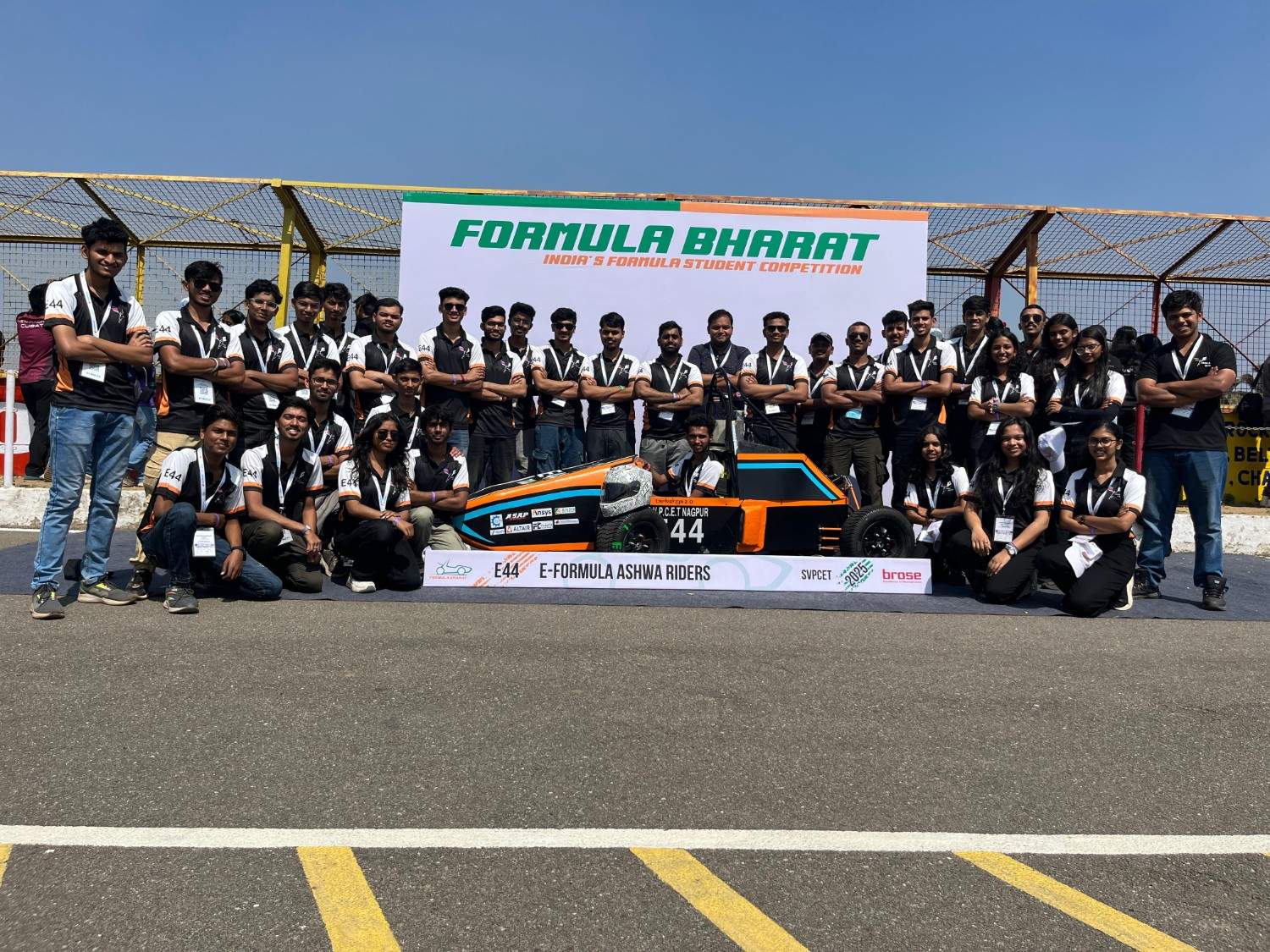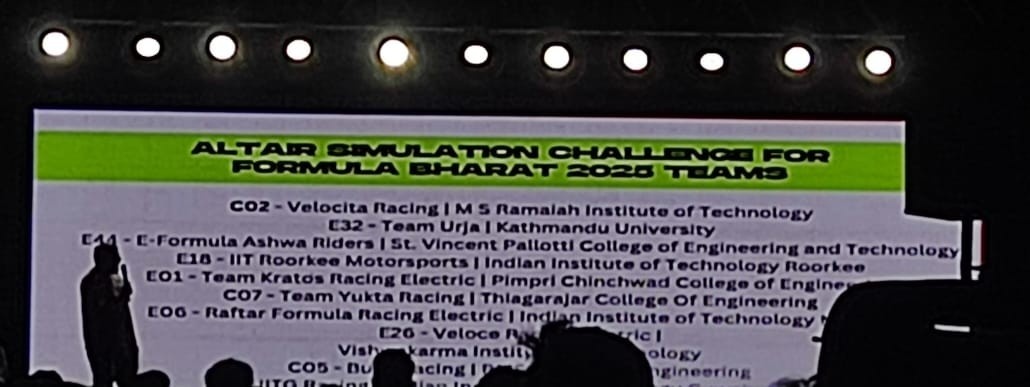+91 7743979315
E-Formula Ashwariders of SVPCET Ranked All India 10

The E-Formula Ashwariders of SVPCET participated in Formula Bharat Electric 2025 from January 22–27 at Kari Motor Speedway, Coimbatore, Tamil Nadu, presenting their third legacy vehicle, Tarkshya 2.0, which featured a data acquisition system to enhance its performance. With dedication and teamwork, the team proudly secured AIR 10 out of 47 teams. A total of 33 students participated this year, led by Bhuwan Hukare, the Captain, Pushkar Meshram and Hardik Bhure, the Electrical Head and Dhaval Barai, the Statics Head.
Day 0 began with team registration, unloading the vehicle, finalizing the setup of the pit, and managing related tasks within subdivided groups. An ESO briefing was held, followed by the first Accumulator Inspection (AI). During the inspection, feedback on the completion of the harness was well received and issues related to the handcart brakes and adjustments to the thermal harness were worked on overnight.
Day 1 started with a mandatory team photo session, followed by pre-tech inspections. During the electrical technical inspection, minor concerns were addressed, including adjustments to PCB installation and LV battery mounting. The mechanical inspection highlighted small issues, such as steering play and harness adjustments, with a key focus on "Percy," which needed to meet compliance standards.
Simultaneously, the accumulator inspection provided valuable feedback for further improvements.
Day 2 began with the accumulator, mechanical, and electrical inspections progressing smoothly. The vehicle underwent its second attempt at the electrical inspection, where minor issues like improper insulation and loose wiring were identified, halting further progress. During the accumulator inspection, scrutineers requested FEA (Finite Element Analysis) reports and calculations for the walls of the container.
The mechanical inspection was successfully cleared, with feedback provided to add jam nuts on the suspension, adjust the steering play, and improve insulation. The scrutineer also commended the vehicle’s clean manufacturing and assembly.
With mechanical approval secured, the team focused on addressing the remaining issues to obtain the accumulator inspection clearance, which was required for the mechanical inspection sticker.
Day 3 began with a tight timetable, focusing on completing the electrical and accumulator inspections. The team worked on connecting the harness to the PCB box and making the required adjustments before attempting the electrical inspection for the third time.
During the inspection, a significant issue was identified—the High Voltage Disconnect (HVD) temperature rating did not meet the required standards. Since the HVD is a critical component, the team quickly sourced last year's HVD, which complied with the necessary specifications, and began replacing it in the hot pit.
Meanwhile, the accumulator inspection was underway. The FEA of the accumulator mounts and stack was completed, and HV and LV wiring was organized. However, during the live test, an IMD-AMS latch failure caused issues with the PCBs, which required immediate troubleshooting. The LV Box was taken back to the hotel for continued work as the team focused on finding a solution.
Day 4 marked the final push, with the team preparing for the final electrical and accumulator inspections. The last attempt at the Electrical Technical Inspection (ETI) was made after reviewing and correcting all previous points. The team successfully passed the electric inspection (without the accumulator), a notable achievement considering many teams struggled with this.
With only the accumulator inspection remaining, the team attempted the live test. Unfortunately, a failure in the actuator isolation relays (AIRs) during the test prevented the team from passing the accumulator inspection, thereby halting progress.
Despite this setback, the team had made significant progress, passing both the mechanical and electric inspections for the first time. While the failure in the accumulator inspection was disappointing, the team gained valuable lessons from the experience.
That evening, the team was honored with the Altair Simulation Competition award and a ₹10,000 cash sponsorship, recognizing the team's dedication and technical excellence.
Day 5 started with a sense of accomplishment, despite some disappointment. The team celebrated one of its proudest achievements: securing the Altair sponsorship for the second consecutive year. This accomplishment highlights our ongoing commitment to innovation and simulation-driven design, strengthens our relationship with industry leaders, and opens doors for future opportunities.
Additionally, Bender contributed significantly by providing an Insulation Monitoring Device (IMD) valued at over ₹60,000. This support played a key role in enhancing technical resources and capabilities for the competition.
Out of 47 electric teams nationwide, E-Formula Ashwariders achieved an impressive AIR 10 overall, marking a significant milestone for the team.
In terms of team standings, out of 47 teams, E-Formula Ashwariders achieved impressive rankings across various categories, securing an AIR 10 overall, AIR 12 in Cost and Manufacturing, AIR 18 in the Engineering Design Event, AIR 23 in Concept Resource Management (CRM), and AIR 10 in the Business Plan Presentation.
The team is deeply grateful to the key individuals whose unwavering support and guidance have been instrumental in their journey. Thanks to Fr. Dr. Paul Chandrankunnel, Director, SVPCET, Fr. Siju Jose, Financial Administrator, Prof. R. B. Gowardhan, Institute Mentor, Dr. Vijay M. Wadhai, Principal, Dr. Sushant S. Satputaley, HoD, Mechanical, Dr. Nitin K. Dhote, HOD, Electrical, Dr. Harish V. Rajurkar HoD, Electronics and Telecommunication, Dr. V. C. Sontake, Co-ordinator, SAE Collegiate Club, Prof. Atul Kumar Saxena, Faculty Advisor, and Prof. H. G. Nagpure, Faculty Advisor, FAR.
Thanks also to the esteemed sponsors: Bender, GM Engineering, Flauta Customs, ASAP Motor Sports, Altair, Vaashi, and PCB Power, whose invaluable support has played a significant role in advancing the boundaries of innovation and excellence.





